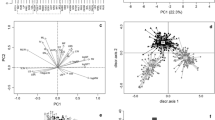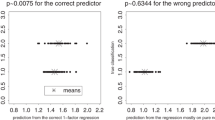Abstract
Five years since Springer published my first book on morphometrics (Elewa 2004), this short interval has shown rapid evolution in the subject.
Access provided by Autonomous University of Puebla. Download chapter PDF
Similar content being viewed by others
Keywords
These keywords were added by machine and not by the authors. This process is experimental and the keywords may be updated as the learning algorithm improves.
Five years since Springer published my first book on morphometrics (Elewa 2004), this short interval has shown rapid evolution in the subject.
At this point, I should note that the review made by Dr. Zelditsch (http://www.nhm.ac.uk/hosted_sites/pe/2005_2/books/morpho.htm) on the first book of 2004 is not convincing to me, despite it contains positive points, for the following reasons:
-
1.
I wrote in the introduction of the book, as well as Prof. Rohlf did in the preface, that this book is principally oriented to systematists. Therefore, most applications were focused on systematics. Consequently, the stress on that the book did not involve some other branches is out of place.
-
2.
One of the successful aims of the book was to show beginners how to use different techniques of morphometrics for solving different problems in systematics.
-
3.
Another aim was to invite biologists and paleontologists to work together for solving their taxonomic problems in a compatible manner.
-
4.
Proudly, the book was one of the earliest books to introduce examples of 3-D morphometrics (Chap. 7 of Kaandorp and Garcia Leiva; Chap. 17 of Harvati).
-
5.
All over all, the book is considered by NHBS Environment Bookstore (http://www.nhbs.com/bioinformatics_cat_477-530-.html) as one of the best and most popular books related to bioinformatics on Earth. It is arranged at higher rank than many well known books on morphometrics. Also, it is considered by many famous bookstores as one of the bestselling books worldwide.
Anyway, morphometrics as a science attracted several students and researchers with broad interests due to the urgent need for quantification and visualization of shape to solve numerous problems related to wide ranges of scientific research.
Earlier, in the seventieth of the last century (1971), when Blackith and Reyment published their book on multivariate morphometrics, this subject was new and applications were almost limited to solve biological problems. Thereafter, morphometrics became known for some other branches (e.g. geology and behavioral sciences).
In the new century, many other branches of science have been deeply involved (e.g. medicine, geomorphology, anthropology, art, and even resolving criminal mysteries through analyzing shape of footprint and shoes print).
Another progress of this subject is clearly related to the use of 3-D moprhometrics (see Figs. 1.1, 1.2, and 1.3 by Rob O’Neil). Although 3-D morphometrics is in its earlier stages, however I remember the words of Prof. Rohlf, in the preface of my first book, who said then that the next few years we are likely to see very exciting new developments that should add even more power to morphometric studies in systematics.
Prof. Norman MacLeod, who is one of the famous experts in the field, stated, in his 2005 review of the book titled “Geometric Morphometrics for Biologists – A Primer”, that the authors set out to write such a book for the audience best positioned to appreciate a primer: those with no more than undergraduate mathematical training who want an emphasis on applications rather than theory. He added that there is certain need for such treatment. He also indicated that canonical modern morphometric texts are too technical and abstract to be fully understood by those not interested in making a commitment to the mathematics. Simultaneously, he said, collections of generalized applications articles are too eclectic and lack the unified focus necessary to be used as comprehensive introductions, while the special-topics collections are too focused and contain too much nonmorphometric material. At the end of the paragraph Prof. Macleod asked – Is this the primer we’ve all been waiting for?
Keeping this in mind, the aim of the present book is introduced in the following lines through explaining my philosophy of editing two books related to morphometrics within short interval.
Essentially, morphometricians should have basic knowledge of mathematics and statistics to understand how they can solve their problems with suitable and effective techniques. In fact, we all know that many colleagues are not specialized in mathematics. Therefore, the goal of editing this book lies in two points:
-
1.
To facilitate the understanding of morphometrics through introducing simple methodological approaches with examples. Actually, many books dealing with morphometrics appeared since the pioneer work of Prof. Bookstein (1989, 1991). These books (e.g. Marcus et al. 1993; Rohlf and Bookstein 1990; Marcus et al. 1996; Small 1996; Dryden and Mardia 1998; Macleod and Forey 2002; Zelditsch et al. 2004; Julien 2008) are almost oriented to morphometricians with good knowledge of mathematics.
-
2.
Confirming the effectiveness of morphometrics in resolving problems related to broad interests.
To come to the point, this book represents an up to date extension to my first book on morphometrics that was published in the year 2004 with Springer-Verlag. The previous book was successful to represent to readers several applications of morphometrics in the fields of biology and paleontology. Nonetheless, we should think of books that could attract more readers on the subject through publishing books with simple scientific issues and modern techniques as well as up to date information on the subject matter with examples. That is why I aimed to publish the book in hand.
Since the seventieth of the last century (1971), when Blackith and Reyment introduced their book on multivariate morphometrics, there were no books focused on morphometrics for nonmorphometricians. This book is aimed to introduce the subject in its simplest form, keeping in mind that the readers have poor knowledge of mathematics and statistics. Yet, we cannot neglect the progress of this branch of science through introducing new ideas with modern techniques and applications.
To achieve the goal, I arranged the book in the form of textbook style with input of well known morphomometricians. So, we can have the two advantages assembled together; the style of textbook and the experience of several experts in the subject. It is not my way this time (it is different from what I made in my first book on morphometrics) to assemble papers representing applications of different groups of organisms. Therefore, the book is divided into four divisions:
-
1.
Part one: Introduction and historical review of the subject.
-
2.
Part two: Methodological approach (quantification of shape, and traditional and geometric morphometrics).
-
3.
Part three: Applications.
-
4.
Part four: Scope to the future of morphometrics.
Accordingly, the book includes, at first, four reviewing and methodological chapters with examples, adding to this introduction (Chap. 2, by Reyment, as a historical review of the subject; Chap. 3, by Krieger, on quantification of shape; Chap. 4, by Strauss, on discriminating groups of organisms; and Chap. 5, by Barcelo, on visualizing archaeological data). Then, there will be different chapters focusing on applications. Finally, an interesting chapter, written by Strauss, on the future of morphometrics is included, followed by a short note on morphometrics and cosmology by Elewa, and ended with a worthy of note chapter by Hammer on the advantage of integrating morphometrics with both general statistical and special ecological analysis modules in the same program, with special reference to the PAST software Package (Hammer et al. 2001).
Following my edited books with Springer, I invited an exceptional group of specialists to write on the subject. Therefore, I would like to thank them all, and particularly Prof. Rich Strauss (USA) for writing the foreword as well as two chapters for the book. The publishers of Springer-Verlag are sincerely acknowledged. I am also grateful to the staff members of Minia University of Egypt. Rob O’Neill, the acting director and research associate of the Digital Arts Research Laboratory, Pratt Institute, USA, is deeply acknowledged for providing me with some amazing pictures of his own work to use in this book.
Certainly, morphometrics became one of the most popular topics for students, at all levels, researchers, and professionals. Accordingly, this book represents advanced ideas and useful outline, especially for undergraduate and postgraduate students.
Now, if you are interested to know more about “why morphometrics?”, then go through the chapters.
References
Blackith RE, Reyment RA (1971) Multivariate morphometrics. Academic Press, London, 412 pp
Bookstein FL (1989) Principal warps: thin-plate spline and the decomposition of deformations. IEEE Transactions on Pattern Analysis and Machine Intelligence 11: 567–585
Bookstein FL (1991) Morphometric tools for landmark data: geometry and biology. Cambridge University Press, New York, 435 pp
Dryden IL, Mardia KV (1998) Statistical shape analysis. John Wiley & Sons, New York, 347 pp
Elewa AMT (2004) Morphometrics – applications in biology and paleontology. Springer-Verlag, Heidelberg, 263 pp
Hammer Ø, Harper DAT, Ryan PD (2001) PAST: paleontological statistics software package for education and data analysis. Palaeontologia Electronica 4 (1):9
Julien, C (2008) Morphometrics with R. Springer, New York, 316 pp
MacLeod N (2005) Review of the book titled “Geometric Morphometrics for Biologists – A Primer”. The Palaeontological Association Newsletter 58:72–78
MacLeod N, Forey PL (2002) Morphology, shape and phylogeny. Taylor and Francis, London, 304 pp
Marcus L, Bello E, Garcia-Valdecasas A (1993) Contributions to morphometrics. Madrid, Monografias del Museo Nacional de Ciencias Naturale Madrid, 264 pp
Marcus L, Corti M, Loy A, Slice D (1996) Advances in morphometrics. Plenum Press, New York, 587 pp
Rohlf FJ, Bookstein FL (1990) Proceedings of the Michigan morphometrics workshop. Special Publication 2, The University of Michigan Museum of Zoology, 380 pp
Small CG (1996) The statistical theory of shape. Springer, New York, 227 pp
Zelditsch ML, Swiderski DL, Sheets HD, Fink WL (2004) Geometric morphometrics for biologists, a primer. Elsevier Academic Press, New York, 443 pp
Author information
Authors and Affiliations
Corresponding author
Editor information
Editors and Affiliations
Rights and permissions
Copyright information
© 2010 Springer-Verlag Berlin Heidelberg
About this chapter
Cite this chapter
Elewa, A.M. (2010). Why Morphometrics?. In: Elewa, A. (eds) Morphometrics for Nonmorphometricians. Lecture Notes in Earth Sciences, vol 124. Springer, Berlin, Heidelberg. https://doi.org/10.1007/978-3-540-95853-6_1
Download citation
DOI: https://doi.org/10.1007/978-3-540-95853-6_1
Published:
Publisher Name: Springer, Berlin, Heidelberg
Print ISBN: 978-3-540-95852-9
Online ISBN: 978-3-540-95853-6
eBook Packages: Earth and Environmental ScienceEarth and Environmental Science (R0)







